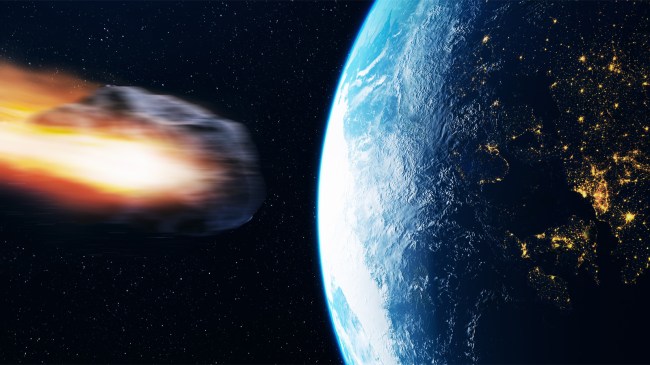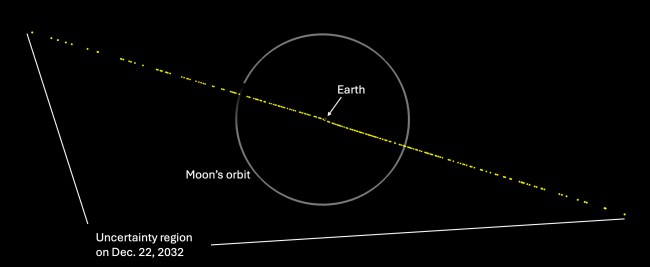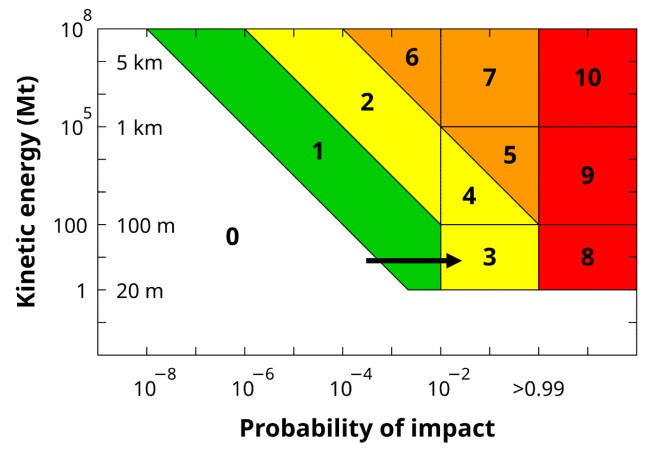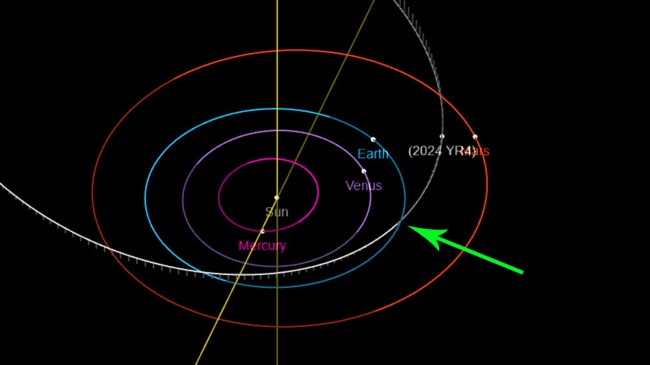iStockphoto
Less than three weeks ago, NASA issued a statement about a “city-killer” asteroid (2024 YR4) that they said has a 1.2% chance of slamming into Earth in the year 2032. Two weeks later, that percentage went up to 2.2%. Then it went up to 2.6%. And now, it’s risen again to 3.1%.
While that number may seem very low, in terms of space it’s actually rather large. In fact, asteroid 2024 YR4 is the only known large asteroid to have an impact probability above 1% – and it is three times that now.
Below, as NASA states, “The yellow dots show the position uncertainty of asteroid 2024 YR4 when it encounters Earth in 2032, based on observations up to January 31, 2025 (orbit solution 40). Only 1.6% of this region intersects the Earth, which is the small dot at the center of the Moon’s orbit.”
On Jan. 31, asteroid 2024 YR4, which is estimated to be about 131 to 295 feet wide, reached level 3 on the Torino Impact Hazard Scale because it has a more than 1% chance of hitting Earth on December 22, 2032.
“It is uncommon for an asteroid to be rated at Torino Scale 3, because that can only happen for an asteroid larger than 20 meters (65 feet) with an impact probability of 1% or greater, which is quite rare for an object of this size,” NASA said in a media release. “Smaller objects have reached higher impact probabilities, even up to 100%, but they are always rated 0 on the Torino Scale because of their size. Small asteroids typically burn up in the atmosphere and rarely cause any damage at all. There have been a few asteroids over the years that have reached Torino Scale 1, with lower impact probabilities, but these all eventually dropped back to Torino Scale 0.”
Should asteroid 2024 YR4 hit Earth, NASA says that right now it will most likely impact somewhere across the eastern Pacific Ocean, northern South America, the Atlantic Ocean, Africa, the Arabian Sea, and South Asia. That means that eight of the top 100 most populated cities in the world including Bogota, Abidjan, Lagos, Khartoum, Mumbai, Kolkata and Dhaka will be in what they are calling the “impact risk corridor.”
In January, Live Science reported that should 2024 YR4 slam into Earth it would “release about 8 megatons of energy upon impact — more than 500 times that of the atomic bomb that destroyed Hiroshima, Japan. Should the asteroid hit Earth, the impact could affect an area up to 30 miles wide.
“If you put it over Paris or London or New York, you basically wipe out the whole city and some of the environs,” Bruce Betts, chief scientist of The Planetary Society, told AFP.
“This object is of particular interest for planetary defense for two reasons: 1) it is large enough to cause localized damage in the unlikely event that it should impact Earth, and 2) while 2024 YR4 has a very small chance of Earth impact in 2032, it has surpassed the 1% impact probability threshold to warrant formal notification of the object to other U.S. government agencies involved in planetary defense as well as to the Space Mission Planning Advisory Group and to the United Nations Office of Outer Space Affairs per the International Asteroid Warning Network’s notification charter,” NASA stated.
“As more observations of the asteroid’s orbit are obtained, its impact probability will become better known,” stated NASA. “It is possible that 2024 YR4 will be ruled out as an impact hazard, as has happened with many other objects that have previously appeared on the NASA JPL asteroid risk list. It is also possible its impact probability will continue to rise.”




